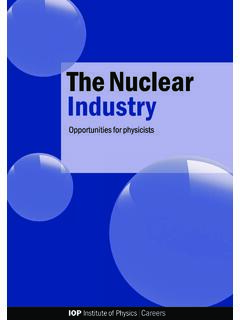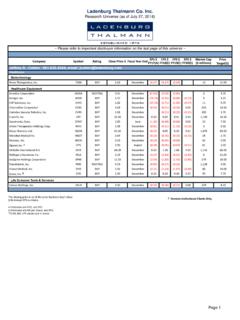Transcription of Bohr Model of the Atom - NTEC
1 BPA bohr Model L4-1 Section 4: bohr Model OF THE ATOM In this section, we describe the structure and behaviour of the simplest type of atom consisting of a nucleus orbited by a single electron only. It addresses the basic question: How do electrons remain in stable orbits around the atomic nucleus? bohr Model of the Atom Fundamental postulates: The Danish physicist Niels bohr , who first presented this Model of the atom, based it on 3 fundamental postulates. (1) Electrons move around the nucleus in circular non-radiating orbits - called stationary states . However, they are not at rest!
2 (2) An atom only emits or absorbs electromagnetic radiation when an electron makes a transition from one state to another. (3) Only certain stationary states are allowed: those where the orbital angular momentum of the electron is given by 2/nhnL ( ) where n is an integer 1 (n = 1, 2, 3 .. etc.) and h is Planck's constant. This is known as the quantization of angular momentum. The equation implies that an integer number of wavelengths fit round the orbit: L = pr = nh/2 whence 2 r = nh/p = n ( ) since, = h/p, (de Broglie relation) Given this condition, amplitudes of successive orbits will be in phase - reinforce each other and generate a standing-wave pattern.
3 These are the allowed waves. The superposition of wave amplitudes of successive orbits with any other wavelength will average to zero and are not allowed. A full quantum-mechanical calculation gives the same allowed states as the bohr Model . - The general result then is that angular momentum is quantized, an integral number of a basic unit h/2 . r Condition: Only waves with an integral number of de Broglie wavelengths around the orbit are allowed. r BPA bohr Model L4-2 SIZES OF ALLOWED ORBITS Classically, for an orbiting electron (mass m, charge -e and speed v), the centripetal force is balanced by the electric (Coulomb) force: 2 0224erZrmv ( ) For hydrogen, Z = 1, so: 2 0224errmv ( ) From Equation ( ): 32223232322224)(mrhnmrLmrprmrrvmrmv ( ) Substituting into Equation ( ).
4 2 0232224e4rmrhn whence, the orbit radius 022202eanmhnr ( ) a0 is called the bohr radius - radius of the innermost (n = 1) orbit of the hydrogen atom. a0 = 0h2/( me2) = 10-11 m = . ( ) ENERGIES OF ALLOWED ORBITS First, consider hydrogen: Using Equation ( ): rmv0228e21KE ( ) Potential (Coulomb) energy is r024ePE ( ) PE is negative because electron and proton charges are of opposite sign. Total energy E = PE + KE rrrE0202028e8e4e ( ) The minus sign means energy is required to remove the electron This energy is called the binding energy.
5 Substituting for r from Equation ( ) gives the energies of other allowed states: 21220428e1nEhmnEn ( ) Lowest (ground) state of hydrogen: E1 = eV BPA bohr Model L4-3 QUANTUM NUMBERS AND ENERGY LEVELS n r E 1 a0 E1 2 4 a0 E1/4 3 9 a0 E1/9 4 16 a0 E1/16 -- -- -- ZanmZhnr022202e ( ) and the energies ( ) These allowed energies are called energy levels. Allowed energy levels for the hydrogen atom. Normally, the electron is in the lowest state (n = 1), the ground state. It can gain energy from electromagnetic radiation, collisions with other atoms, etc.
6 And be promoted into one of the higher levels, to an excited state of the atom. Note: the energy gained must equal the energy required. If the electron acquires energy > eV, it is liberated from the atom altogether. The atom is ionized. Only certain orbit radii and total energies are allowed both electron radius and energy are quantized. n is called a quantum number Generalization to other single-electron atoms: Replace `e2 ' by `Ze2 ' - singly ionized helium, He+ (Z = 2) or doubly ionized lithium, Li++ (Z = 3), etc. Free electron E > 0 Bound electron E > 0 E1 = eV (n = 1) E2 = eV (n = 2) E3 E 0 BPA bohr Model L4-4 ENERGY CONSERVATION AND SPECTRAL LINES An electron in an excited state normally returns very quickly to its ground state, either directly or via an intermediate state.
7 When the electron moves from its initial Ei to its final Ef state, a photon is emitted (or absorbed, if Ei < Ef). The energy of the photon emitted (or absorbed) is given by energy conservation: Eph = h = Ei - Ef. ( ) For hydrogen: ( ) where ni and nf (with ni > nf) are the quantum numbers of the initial and final states. Possible decays from an n = 3 excited atomic state: Possible decays to the ground state of a hydrogen atom: h h h E3 (n = 3) E2 (n = 2) E1 (n = 1) E3 (n = 3) E2 (n = 2) E4 (n = 4) E1 (n = 1) E5 (n = 5) All these transitions correspond to discrete photon energies.
8 A series of sharp spectral lines are produced. All these lines are in the ultra-violet region of the em spectrum. They are called the Lyman Series. BPA bohr Model L4-5 Initial quantum number Photon energy (eV) Wavelength = hc/E 2 (1 - 1/4) = nm 3 (1 - 1/9) = nm 4 (1 - 1/16) = nm 5 (1 - 1/25) = nm --- --- --- (1 - 1/ ) = nm Electrons from states with ni > 2 can return, initially, to the first-excited state (nf = 2), emitting one photon and then to the ground state emitting a second photon, with Eph = eV, which is part of the Lyman series.
9 Photons from transitions to the first-excited, (n = 2) state of the hydrogen atom form another series of spectral lines. This series is in the visible part of the spectrum from yellow, for the lowest energy, to violet for the highest energies. It is called the Balmer Series. Initial quantum number Photon energy (eV) Wavelength = hc/E 3 (1/4 - 1/9) = 657 nm 4 (1/4 - 1/16) = 487 nm 5 (1/4 - 1/25) = 434 nm 6 (1/4 - 1/36) = 411 nm --- --- --- (1/4 - 1/ ) = 365 nm The Lyman series E3 (n = 3) E2 (n = 2) E4 (n = 4) 4)4) E1 (n = 1) E5 (n = 5) eV Other series of spectral lines correspond to transitions for which Ef = E3 (the Paschen series) Ef = E4 (the Brackett series) and so on.
10 These are all in the infra-red part of the spectrum.







